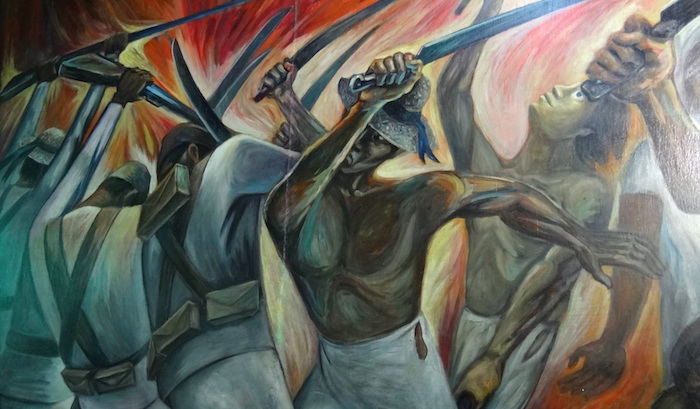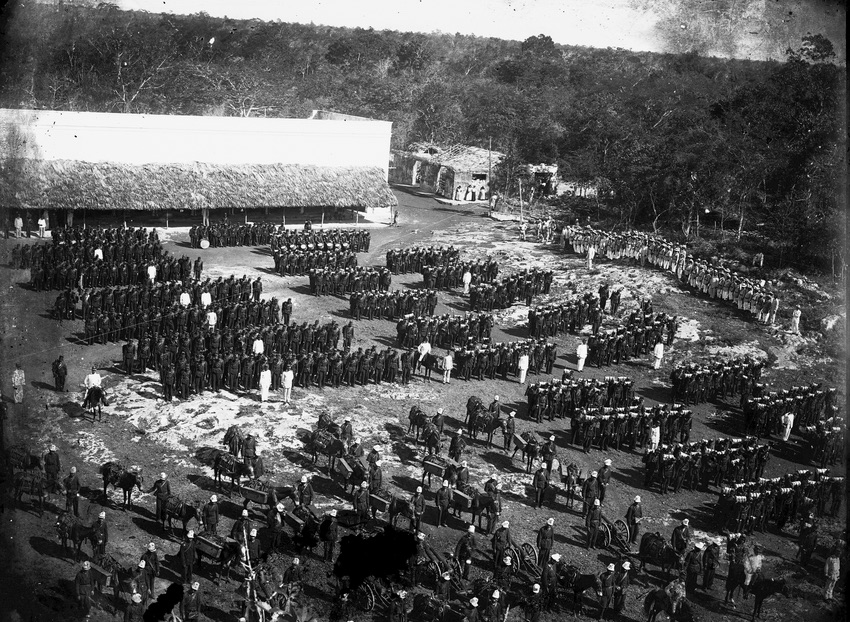As I’ve written about before, the best way to make a party of PCs stand out in a large war or battlefield is to put them in special situations where they can really shine. Before, we looked at three such situations during the Crusades that you can model an encounter on. Now we’re going to dive into three such situations during the Caste War of the Yucatan.
Last week, we talked briefly about one of the precipitating incidents of the genocidal Caste War between Maya and criollo fighters in the Yucatan peninsula. All war is hell, but this one was particularly monstrous. It lasted over 50 years, depopulated large swaths of the Yucatan peninsula, and both sides carried out atrocities at every opportunity. Still, there were moments that were more interesting than appalling, and it’s three such incidents we’re going to be looking at in this post.

Image credit: Adam Jones, Ph.D. Released under a Creative Commons Attribution-Share Alike 3.0 Unported license.
in 1848, a rebel army of indigenous Maya seemed on the verge of total victory over the forces of their criollo (white, Spanish-descended) masters. After three centuries years of virtual enslavement, the Maya had driven the criollos before them across the peninsula, and stood ready to sack the state capital at Mérida. Their revenge on Cortez was at hand, 330 years later.
But then they went home. Years later, the son of one of the Maya leaders explained that they observed the arrival of a particular species of winged ant that always presaged the annual rains. The Maya soldiers weighed their desire for freedom against their desire to feed their families, and left to prepare their fields for planting. These soldiers were subsistence farmers. If they missed the start of the rainy season, there would be no harvest this year. They just went home.
The Maya leadership and the hardcore fighters couldn’t take Mérida on their own. They retreated to secret camps, deep in the jungle, to wait for next year to try again. There was no unified Maya command structure. Instead, each Maya leader his own outpost for his own men. Each had its own cenote – a sort of cave with a collapsed roof, creating an open well – and its own cluster of thatched-roof houses.
Cecilio Chi, the Maya leader the Criollos feared most, made his outpost in the jungle 35 miles southeast of Valladolid. Chi’s secretary had secretly been sleeping with the leader’s wife. The secretary killed Chi, either so the lovers could be together or to collect a reward from the criollos. It didn’t work. His crime was discovered, and he fled to the rafters under the thatch. He shot at Chi’s loyalists through the thatch until they cut through the thatch, hauled him out, and hacked him to death with machetes.
While the particulars of the case are unusual, the idea of an adulterous secretary who kills the military superior he’s been cuckolding ports easily to most any setting. Give the PCs the opportunity to discover the affair while they’re on campaign! What do they do with this knowledge? If they don’t act on it, this is the result: a critical general dead and the war effort stymied. Had Cecilio Chi lived, the Caste War might not have dragged on for fifty more years, and your fictional general could be more important still. This is a case where a handful of nosy investigators really can change the course of a war.

Fast-forward to 1866. The Caste War has been going on for 19 years. Reinvigorated criollo forces pushed the Maya rebels into the uninhabited swamps in the east of the peninsula, but were unable to root them out. Here, the rebels created a new nation united by a new religion: the Talking Cross. This faith unites traditional Catholicism with pre-Columbian beliefs, especially in idols that speak. The Cruzob, the citizens of this new nation, launched annual attacks across the vaguely-defined border, and the Yucatecans (criollo, criollo-aligned mestizo and Maya, and defeated Maya) returned the favor.
In 1866, the Mexican emperor Maximilian tried to settle the Cruzob ‘problem’ with a major offensive of federal troops. No longer was the Caste War going to be a strictly Yucatecan problem. The federal troops made their headquarters at the town of Tihosuco, near the Cruzob border. In August, after the corn was planted, the Cruzob appeared. They cut off the only road connecting Tihosuco to the rest of Mexico and besieged the town. Supplies in Tihosuco ran out quickly, and there was concern the garrison would surrender before they could be rescued.
Someone needed to tell Tihosuco that help was on the way. A single enlisted man, Corporal Pina, volunteered to get the message through. Setting aside his uniform, he mingled with the Cruzob besiegers until the time was right. Then he made a run for the defenders’ barricades. As he ran, the Cruzob opened fire on this apparent traitor and the garrison opened fire too, figuring this had to be some sort of Cruzob ploy. Somehow, Pina made it through.
Tihosuco hung on until the relief force punched through the Cruzob lines, bringing enough reinforcements and supplies to barely withstand the final Cruzob assault two weeks later. Nonetheless, the Yucatecans recognized that Tihosuco had become too exposed and abandoned it – and the Cruzob state survived Emperor Maximilian’s offensive. Tihosuco was a tactical victory for Mexico, but a strategic victory for the Cruzob.
Sieges require a little cleverness to make fun at the table. The previous ‘PCs on the Battlefield’ post focused on schemes and stratagems, but an action movie-style mad dash is another great way to handle it. Call for a few rolls to get the defenders to stop shooting, dodge incoming fire, and reach the barricades before the whole besieging army turns its guns on the party. It’s a fast, memorable scene, and it’s way more fun than ten thousand repetitive rolls to see how many Uruk-hai you kill at Helm’s Deep.

Fast-forward to 1901. After fifty-four years of war, and countless epidemics and bad harvests, the Cruzob were down to a quarter of their initial strength. Even thous were weakened by disease and malnutrition. Meanwhile, the industrial revolution and the repeating rifle arrived in Mexico. When General Ignacio Bravo started buidling a railroad under armed guard through the Cruzob homeland, he faced little resistance.
The railroad’s target was a place called Chan Santa Cruz. This was the spot where the sacred crosses first spoke to the Maya. What began as a shrine expanded into a sort of temple-town built on a Spanish colonial plan. Perpendicular streets formed sixteen blocks, each surrounded by a stone wall containing a handful of thatch houses. A flat, rocky town square at the center of Chan Santa Cruz was surrounded by stone buildings: the homes of the Cruzob religious and military leaders, a prison, and at least seven barracks for the rotating companies of troops to guard the capital. Looming over the square was the Balam Na, the church that held the first talking cross. Scattered throughout the town were redoubts and defendable walls, which the Cruzob could fire from and retreat, drawing an attacker in to be cut off.
On April 17th, a muleskinner from General Bravo’s army went looking for a lost animal and discovered some empty houses in the jungle. As he followed the line of buildings, he came to realize he’d stumbled upon Chan Santa Cruz. The temple-capital was abandoned.
Having your PCs stumble on an abandoned enemy stronghold is a great opportunity to humanize the enemy, introduce some critical information the enemy left behind, or just create a sense of wonder and dread. You can also set it up as a trap. General Bravo was not the first Mexican officer to reach Chan Santa Cruz. He found the place well and truly abandoned, but his predecessors found it set up as an ambush. The Cruzob filled their wells with stones, cut off the Mexicans’ line of retreat, and sniped at them from every tree. Can your wonder-struck PCs suss out the threat before the rest of the army arrives?
–
The Caste War ended with a whimper. The criollos were unable to keep the caste privileges they’d fought to maintain. The Cruzob gradually died out or joined the periphery of Mexican society. The war accomplished little for either side, and hundreds of thousands of people – mostly civilians – died for nothing.
Source: The Caste War of Yucatan by Nelson Reed (1964)






